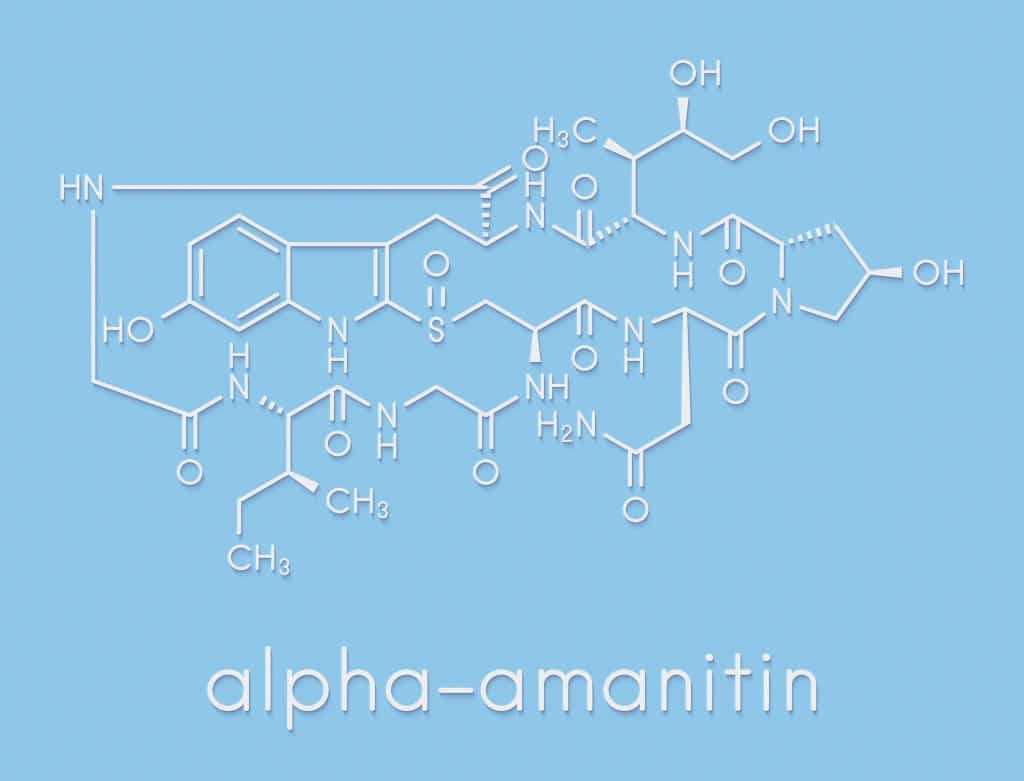Amanita mushrooms are growing in popularity, but we’re only talking about a certain kind. Yet another kind, which is way more dangerous, is also gaining attention for its properties as a medicine. Read on to learn more about Amanita phalloides, and its possibility as a cancer fighting agent.
Amanita mushrooms
The name ‘Amanita’ refers to an entire genus of similar mushroom species. Under every genus resides different species that have something in common, while not being the same. All Amanita mushrooms are considered poisonous, though different species contain different compounds that give them varying levels of danger. Some might make you sick, some might get you high, and some might certainly kill you.
Under the Amanita genus, there’s one particular species we talk about a lot, Amanita muscaria, also known as ‘fly agaric’ mushrooms. Though there is fear for some because of their classification as poisonous mushrooms, this particular species isn’t known to kill. But it is known to cause psychoactive and hallucinogenic effects.
One of the only stories that does exist claiming these mushrooms took a life, has to do with a guy named Count de Vecchj who reportedly died after consuming a plate of the raw mushrooms. This never went past speculation as no specimen was ever tested, or the mushroom of interest, confirmed. And as it stands as literally the only story of its kind, it seem less likely that he was killed by Amanita muscaria, and more likely that another mushroom found its way into the mix.
Thanks for joining. Access our direct email updates by subscribing to the Cannadelics Weekly Newsletter, and also receive great deals on everything from cannabis buds, vapes and related equipment, to edibles, smoking devices, cannabinoid compounds (like HHC), and lots more. We’ve got it all, come get it!
Though they won’t kill a person, they can cause sickness because of a compound they contain called ibotenic acid. Luckily, ibotenic acid isn’t heat stable, and when boiled, it decarboxylates to the desired compound, muscimol. Thus, there’s a way to prepare these particular mushrooms to avoid sickness altogether.
Amanita muscaria is just one of about 600 species that reside under the genus Amanita, and a variety of them really are dangerous. Mainly because some contain compounds called amatoxins, which are incredibly toxic, and often lead to death when consumed. Unlike ibotenic acid, amatoxins can’t be minimized or avoided through boiling. Amatoxins are found in many Amanita species, as well as species under a couple other genera, like Lepiota, Galerina, and Conocybe.
It’s approximated that about 90% of all mushroom poisoning deaths, are from mushrooms that contain these amatoxins; the deadliest of which is α-amanitin. There is one particular species which is associated with up to 50% of these deaths alone, and it’s an Amanita mushroom. Amanita phalloides, appropriately nicknamed Death Cap, has the highest death toll of all the deadly mushrooms out there.
Amanita phalloides – what happens when you eat it?
Amanita phalloides contain amatoxins, like the super lethal α-amanitin. α-amanitin works by binding to RNA polymerase II irreversibly, which prevents further protein synthesis and causes dells to die. Quite unfortunately, these mushrooms resemble perfectly safe edible mushrooms, and most poisonings are due to simple misidentification. It’s not a good mistake to make, and up to 50% of poisonings with Amanita phalloides result in death.
Death by Amanita phalloides is a long and painful process. After ingestion, it takes about six hours for symptoms to come on. This is followed by a three-phase process. The first phase, dubbed the ‘dysentery phase’ lasts about 6-24 hours. As per the name, this phase looks like dysentery with the mushroom eater experiencing extreme vomiting and diarrhea. Following that there can be a false recovery stage where it seems the patient has gotten better. This can last from 24-72 hours. Last comes the hepatorenal phase, which can go on for 4-9 days, and results in multiorgan failure, seizures, coma, and finally death.
What can be done for a person poisoned by Amanita phalloides? Unfortunately, not much directly. Decontamination efforts are key, like promoting amatoxin elimination via the liver, and interrupting enterohepatic recirculation of amatoxins, using antidotes like N-acetylcysteine and silibinin. How useful these compounds are is undetermined, though, with only speculation that they might be helpful. In cases of acute liver failure, a transplant is required. Beyond that, there is no actual cure for this problem.
Everything You Need to Know…
Amanita phalloides…for cancer treatment
If everything above makes you think it’s a bad idea to eat these mushrooms, you’re correct. There don’t seem to be any benefits attached to consuming them when it comes to personal health and survival. However, that doesn’t mean they can’t provide any benefit at all. And as it turns out, Amanita phalloides is studied for the treatment of cancer. Imagine that, taking something that’s deadly to eat, and creating a medicine out of it, for something like cancer.
Back in 2010, a study came out called Tumor Therapy with Amanita phalloides (Death Cap): Stabilization of B-Cell Chronic Lymphatic Leukemia. In it, researchers point out that in tumor cells, there’s more RNA polymerase II activity, than there’s supposed to be. And that the specific amatoxin mentioned before, α-amanitin, works by essentially slowing down or stopping RNA polymerase II. The study was done on only one patient with leukemia. He was given different doses, and his leukemic cell count was kept track of.
Results showed that “The former duplication time of leukemic cells was 21 months. Within a period of 21 months, the cell count is stabilized to around 105/μL. No leukemia-associated symptoms, liver damage, or continuous erythrocyte deprivation occur.” Researchers concluded that “This new principle of tumor therapy shows high potential to provide a gentle medical treatment.”

In 2021, a systematic review came out called Defining a Role of Amanita phalloides Toxins in Cancer: Research and Therapy, with the goal of examining the therapeutic benefits of α-amanitin for different kinds of cancer. The reason being that standard treatments like chemotherapy cause too much damage to healthy cells, while tumors become resistant to it. Dilutions of Amanita phalloides, noted the study, have been used for over 300 years.
The author concluded, “in recent years, α-amanitin of amanita therapy received an increased attention as a gentle medical treatment in cancer therapy is more suitable.” Almost sounds funny considering we know how dangerous these mushrooms are when used incorrectly.
The author continued, “Through my readings to different researchers’ reports, no severe side effects happen and no clinical symptoms when the patient used the amanita therapy.” And then says, “Amanitin inhibits the activity of tumor cells. Thus, α-amanita can first be used as a tumor-specific therapy. Antiandrogen drugs, chemical therapy, radiation or prostatectomy can be used at subsequent levels.”
What causes death, can save you
It truly creates what seems like a contradiction. Mushrooms we are warned away from for their deadliness, also seem able to effectively inhibit cancer, while not hurting the specimen in question. An article from 2019 is titled well, Notorious killer yields a life-saving toxin. It details how in 2014, analogues of α-amanitin from Amanita phalloides were developed by Germany’s Heidelberg Pharma, specifically to treat different kinds of cancer. The company then went on to test antibody drug conjugates (ADCs) from this poison.
The article explains, “An ADC consists of a monoclonal antibody specific to the antigen associated with the tumor cells, the cytotoxic agent, and a chemical linker. Once the ADC enters the target cells, the cytotoxic agent detaches itself from the linker, which selectively attacks the tumor cells. More specifically, a-amanitin is a bicyclic octapeptide that inhibits RNA Polymerase II (Pol II), which drives DNA transcription. It stops Pol II from producing malfunctioning proteins in the cell that drive cancer formation.” Basically, at the right low doses, it does to the cancer, what it does to kill humans; but without damage to the humans, only to the cancer.

Explains Dr. Kaveh Matinkhoo, a postdoctoral fellow, and lead investigator of the research into the creation of synthetic analogues of the compound, “Because of its mechanism of action, it can work on rapidly growing cancer cells and dormant cells. The problem is that a lot of chemotherapeutic agents only work on rapidly growing cells, and after chemotherapy is over, the patient is apparently cured but the cancer comes back a few years later.”
The trick, of course, is to use sub-lethal amounts. Think microdosing. The article goes on to talk about research involving mice in Japan, where the sub-lethal doses injected of α-amanitin, not only kept the mice from relapsing, but showed strength in dealing with chemo-resistant cancer colonies.
Conclusion
It does make sense. If the α-amanitin compound of Amanita phalloides is strong enough to kill humans, why couldn’t it be strong enough to kill cancer? In the future, we might find ourselves being treated, with the same mushrooms that can kill us.
Welcome readers! Always great to have you with us at Cannadelics.com; where we provide independent coverage of the burgeoning cannabis and psychedelics spaces. Head our way whenever you’ve got a minute to stay informed on everything going on; and sign up to the Cannadelics Weekly Newsletter, to ensure you’re on top of every story.





